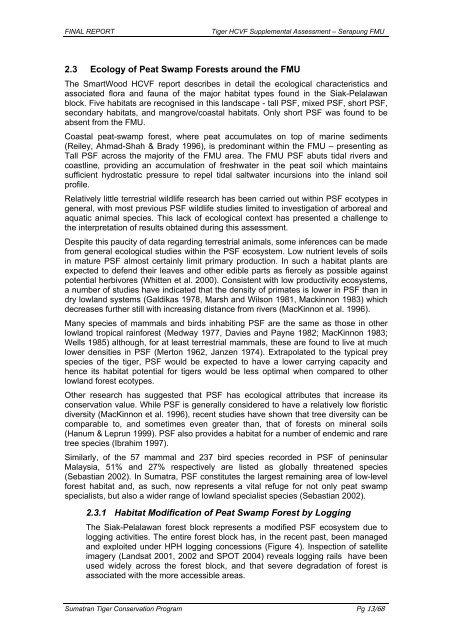A Supplemental HCVF Assessment on the Sumatran Tiger ...
A Supplemental HCVF Assessment on the Sumatran Tiger ...
A Supplemental HCVF Assessment on the Sumatran Tiger ...
You also want an ePaper? Increase the reach of your titles
YUMPU automatically turns print PDFs into web optimized ePapers that Google loves.
FINAL REPORT <strong>Tiger</strong> <str<strong>on</strong>g>HCVF</str<strong>on</strong>g> <str<strong>on</strong>g>Supplemental</str<strong>on</strong>g> <str<strong>on</strong>g>Assessment</str<strong>on</strong>g> – Serapung FMU<br />
2.3 Ecology of Peat Swamp Forests around <strong>the</strong> FMU<br />
The SmartWood <str<strong>on</strong>g>HCVF</str<strong>on</strong>g> report describes in detail <strong>the</strong> ecological characteristics and<br />
associated flora and fauna of <strong>the</strong> major habitat types found in <strong>the</strong> Siak-Pelalawan<br />
block. Five habitats are recognised in this landscape - tall PSF, mixed PSF, short PSF,<br />
sec<strong>on</strong>dary habitats, and mangrove/coastal habitats. Only short PSF was found to be<br />
absent from <strong>the</strong> FMU.<br />
Coastal peat-swamp forest, where peat accumulates <strong>on</strong> top of marine sediments<br />
(Reiley, Ahmad-Shah & Brady 1996), is predominant within <strong>the</strong> FMU – presenting as<br />
Tall PSF across <strong>the</strong> majority of <strong>the</strong> FMU area. The FMU PSF abuts tidal rivers and<br />
coastline, providing an accumulati<strong>on</strong> of freshwater in <strong>the</strong> peat soil which maintains<br />
sufficient hydrostatic pressure to repel tidal saltwater incursi<strong>on</strong>s into <strong>the</strong> inland soil<br />
profile.<br />
Relatively little terrestrial wildlife research has been carried out within PSF ecotypes in<br />
general, with most previous PSF wildlife studies limited to investigati<strong>on</strong> of arboreal and<br />
aquatic animal species. This lack of ecological c<strong>on</strong>text has presented a challenge to<br />
<strong>the</strong> interpretati<strong>on</strong> of results obtained during this assessment.<br />
Despite this paucity of data regarding terrestrial animals, some inferences can be made<br />
from general ecological studies within <strong>the</strong> PSF ecosystem. Low nutrient levels of soils<br />
in mature PSF almost certainly limit primary producti<strong>on</strong>. In such a habitat plants are<br />
expected to defend <strong>the</strong>ir leaves and o<strong>the</strong>r edible parts as fiercely as possible against<br />
potential herbivores (Whitten et al. 2000). C<strong>on</strong>sistent with low productivity ecosystems,<br />
a number of studies have indicated that <strong>the</strong> density of primates is lower in PSF than in<br />
dry lowland systems (Galdikas 1978, Marsh and Wils<strong>on</strong> 1981, Mackinn<strong>on</strong> 1983) which<br />
decreases fur<strong>the</strong>r still with increasing distance from rivers (MacKinn<strong>on</strong> et al. 1996).<br />
Many species of mammals and birds inhabiting PSF are <strong>the</strong> same as those in o<strong>the</strong>r<br />
lowland tropical rainforest (Medway 1977, Davies and Payne 1982; MacKinn<strong>on</strong> 1983;<br />
Wells 1985) although, for at least terrestrial mammals, <strong>the</strong>se are found to live at much<br />
lower densities in PSF (Mert<strong>on</strong> 1962, Janzen 1974). Extrapolated to <strong>the</strong> typical prey<br />
species of <strong>the</strong> tiger, PSF would be expected to have a lower carrying capacity and<br />
hence its habitat potential for tigers would be less optimal when compared to o<strong>the</strong>r<br />
lowland forest ecotypes.<br />
O<strong>the</strong>r research has suggested that PSF has ecological attributes that increase its<br />
c<strong>on</strong>servati<strong>on</strong> value. While PSF is generally c<strong>on</strong>sidered to have a relatively low floristic<br />
diversity (MacKinn<strong>on</strong> et al. 1996), recent studies have shown that tree diversity can be<br />
comparable to, and sometimes even greater than, that of forests <strong>on</strong> mineral soils<br />
(Hanum & Leprun 1999). PSF also provides a habitat for a number of endemic and rare<br />
tree species (Ibrahim 1997).<br />
Similarly, of <strong>the</strong> 57 mammal and 237 bird species recorded in PSF of peninsular<br />
Malaysia, 51% and 27% respectively are listed as globally threatened species<br />
(Sebastian 2002). In Sumatra, PSF c<strong>on</strong>stitutes <strong>the</strong> largest remaining area of low-level<br />
forest habitat and, as such, now represents a vital refuge for not <strong>on</strong>ly peat swamp<br />
specialists, but also a wider range of lowland specialist species (Sebastian 2002).<br />
2.3.1 Habitat Modificati<strong>on</strong> of Peat Swamp Forest by Logging<br />
The Siak-Pelalawan forest block represents a modified PSF ecosystem due to<br />
logging activities. The entire forest block has, in <strong>the</strong> recent past, been managed<br />
and exploited under HPH logging c<strong>on</strong>cessi<strong>on</strong>s (Figure 4). Inspecti<strong>on</strong> of satellite<br />
imagery (Landsat 2001, 2002 and SPOT 2004) reveals logging rails have been<br />
used widely across <strong>the</strong> forest block, and that severe degradati<strong>on</strong> of forest is<br />
associated with <strong>the</strong> more accessible areas.<br />
<strong>Sumatran</strong> <strong>Tiger</strong> C<strong>on</strong>servati<strong>on</strong> Program Pg 13/68

















